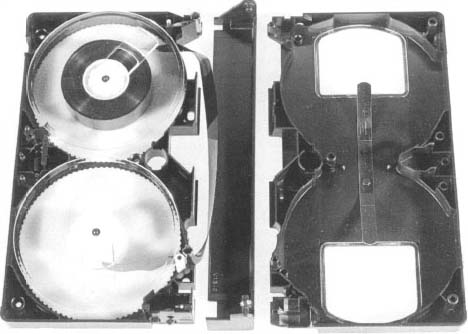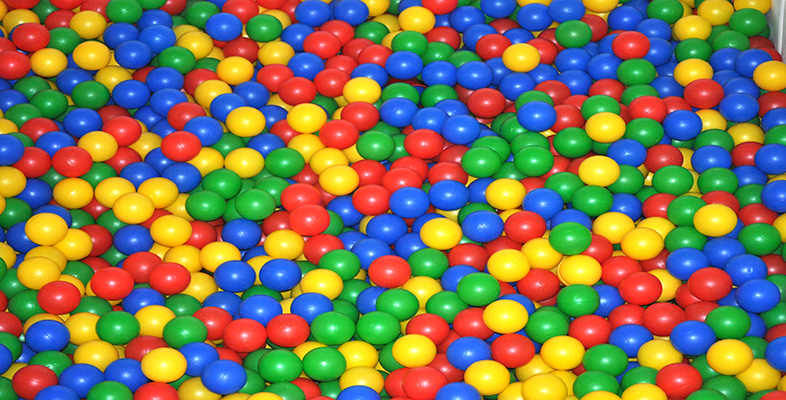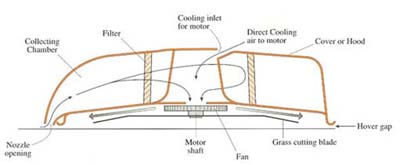1.3.1 Parts consolidation
The most obvious use of polymers is for enclosures for working equipment, such as power and garden tools as well as cooking devices, and electronic products such as computers, video recorders and fax machines (as well as the products used in those machines). They are not just boxes for containment; such plastic enclosures can incorporate carefully designed ribs, webs and flanges on the hidden, inner sides to hold working components securely in place when in operation (Figure 9).

Polymers offer several intrinsic advantages over conventional materials, and they include
-
electrical insulation since non-conducting
-
toughness to resist mechanical abuse such as impact
-
vibration attenuation
-
low weight
-
one shot manufacture.
The final point in the listing may be difficult to appreciate fully since it involves an understanding of the nature of plastics moulding. Put briefly, it means that several separate functions can be incorporated in one (or two, since working parts must be inserted into the housing to make the finished product) component part, the enclosure.
Thus some of the internal ribs of a drill housing will support the electric motor, separate flanges will protect the trigger mechanism, while other inner ribs will form sockets to protect and support the wiring and leads. Even vents for cooling hot parts of the working mechanism can be incorporated into the form of the design during processing to shape without the need for a separate cutting operation. In early designs for such products, the support and protection were provided by separate parts which needed many assembly steps to make the finished product. This was especially true for sheet metal enclosures where complex internal projections are difficult if not impossible to incorporate in a single pressing operation. The underlying design philosophy with plastics materials is known as parts consolidation. The same philosophy can be seen at work in entirely new products where no conventional materials have been displaced, such as the videocassette cartridge (Figure 9).
Exercise 4: You should now watch the video sequence ‘A cut above the rest?’
The video, presented by Peter Lewis from the Open University was recorded in 1983/4 at Flymo-Electrolux Ltd., Newton Aycliffe, Co. Durham, and includes an interview with Peter Ginger, Plastics Division Manager of Electrolux. The video shows the range of polymer processes used by a major manufacturer of consumer goods, and it indicates the way in which advanced technology can be applied both to primary shaping methods like injection moulding and secondary methods like assembly.
Click the 'View document' link below to read pre-viewing comments.
View document [Tip: hold Ctrl and click a link to open it in a new tab. (Hide tip)]
Click the 'View document' link below to read the post-viewing comments.
Self assessment question 1
Figure 10 shows a cross-section of a small lawnmower. It is a hovermower powered by electricity, provided by a cable attached to the mains supply. The 2 kW motor drives the rotor cutting blade in the base of the mower by a direct drive, to which a fan for the downdraft is fitted. It also creates an updraft by means of another fan to suck grass cuttings into a collecting bag. Why is the casing made using a tough plastic like ABS? Would alternative materials such as sheet steel be an appropriate choice for the hood? Give reasons for your answers in terms of
-
materials properties;
-
suitability for function; and
-
ease of manufacture including assembly.
Answer
Being a hover mower, the main casing must be light enough to be lifted by the down draft created by the main fan, despite the effect of the collection fan. Although sheet steel could be made thin and light enough to act as a casing, the complex internal rib system would be impossible to produce in a single operation. In addition, steel would be vulnerable to rusting in normal garden usage. It might be tough enough to withstand abuse, but a preferred option is to use a tough, lightweight polymer such as ABS. Being rubber toughened, it should be capable of resisting external impacts with garden objects as well as stones thrown up by the cutting blade. Two parts could be manufactured, and bonded or bolted to one another after insertion of the motor assembly. The plastic hood offers good electrical resistance compared to highly conducting steel, so is also better on safety criteria.
There is another benefit to product function from parts consolidation, which might also escape superficial attention. All the internal projections improve the overall stiffness of the final product, which must achieve a minimum level to act as a safe and secure platform for the working mechanism. Very often, sufficient product stiffness can be achieved using a constant and relatively thin wall of uniform thickness throughout the housing. So product design, product function, manufacture and material of construction are actually intimately linked.

